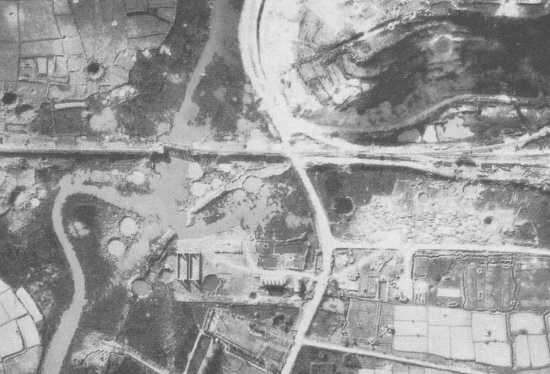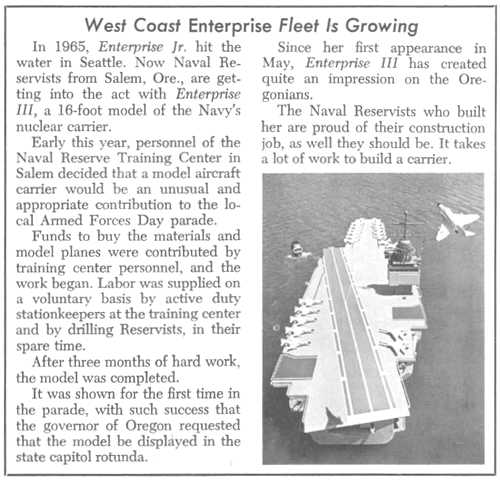
This is a direct reproduction of the original content of ALL HANDS magazine.
©All Hands Magazine, Inc. All rights reserved. Reproduction by permission only.
Navigate through the "pages" by clicking on the page numbers, next or back links at the bottom of your screen or by clicking the links in the Table of Contents.

Aviation Supply Office
The Aviation Supply Office has been in the spare parts business for 25 years.
Before the ASO came into being, aircraft spares were bought by the naval bureaus, naval air stations, and the Naval Aircraft Factory, as they were needed. This system, though efficient enough before World War II when aircraft component parts were few, was too loosely organized to handle the expansion of the Navy's aviation program that followed the fall of France.
In 1939 the Navy was operating little more than 1000 aircraft. In June 1940, Congress authorized the procurement of 15,000 more. A centrally controlled supply system to back them up with spare parts was imperative.
The Naval Aircraft Factory in Philadelphia was selected as the site of the ASO.
In October 1941 ASO was staffed by 200 civilian employees and 14 military, Only a few months later it was filling the desperate needs of the Pacific Fleet after the attack on Pearl Harbor.
By the end of World War 11, ASO's work force had grown to 766 military, and 2050 civilian personnel. Between Pearl Harbor and VJ day, ASO had supplied American and Allied aircraft with spare parts worth well over a billion dollars.
Today, ASO supports more than eight billion dollars worth of aircraft. The two-billion-dollar inventory of stock items that backs up these aircraft demands the most efficient management methods possible. Automation has been the answer.
The Automated Purchase Order System, for instance, makes 50 per cent of ASO's purchases. It slashes the cost and time of the buying cycle, and permits quicker payment to the contractor. Approximately 45 million dollars in purchases are made anually with this system.
Automation also controls communications through the Automated Digital Network.
Other automated systems handle requisitioning and emergency requests for material needed to get grounded aircraft flying again.
With automated techniques adapted for most of the major programs used to supply naval aircraft, ASO has become the electronic nerve center of the entire Navy Aviation Supply System. Its reflexes are conditioned by signals from various parts of the system it controls.
These signals are motivated by the day-to-day issues, receipts and requirements of supply units all over the world. In the past, daily transactions were reported monthly, bimonthly, or, under the best conditions, weekly. Supply information was, therefore, only as current as the last report.
Now, supply actions are reported daily over a worldwide electronic network. One of the most important effects of this immediacy is the speed with which needs are filled. If the Naval Air Station at North Island, Calif., for example, requests six gyroscopes on a Tuesday afternoon, by Wednesday morning computer action has been taken which will start them on their way from NAS Alameda, or the nearest supply unit on the West Coast which has the parts needed.
In the past, the paper mills of ASO ground slowly. Now their shuffling sounds are being replaced by the staccato clicking of computers and aircraft on the flight lines of the Navy are more quickly and economically ready for action.
In 1962, when besieged purchase personnel shouted for help, ASO's electronic cavalry came to the rescue. Between them they worked out a strategy to conquer the onslaught of paperwork that threatened to disrupt the small-purchase system.
The basis of this strategy was an automated small-purchase order program which was begun in March 1963.
As a result of this program, the 10 to 15 documents which previously cluttered a contract folder for a small purchase, have been reduced to two. The annual printing workload has been reduced by at least two Million sheets.
Today ASO supports 8800 aircraft. Its supply system carries a 2.2-billion-dollar inventory of about 400,000 items. Its annual "sales" are about a billion dollars.
The most important of current demands of ASO's multibillion dollar inventory are those that come from the Seventh Fleet and the First Marine Air Wing in Southeast Asia. To keep up with the urgent needs of aircraft operating in and around Vietnam, ASO has worked out an accelerated system of processing called Project Tiger Tom.
The system processes requisitions from Vietnam in four to six hours. Items available in ASO's supply system about 99 per cent of those requested arrive at the Naval Supply Center in Oakland, Calif., within 24 hours.
That kind of service makes for satisfied customers.
traffic Briefing at Sea
A highway patrolman riding a greyhound, and an eight-hour driver improvement course are two more of the means by which the Navy is attempting to cope with the problem of traffic safety.
The destroyer-riding patrolman was from the San Diego division of the California Highway Patrol. He boarded USS Orleck (DD 886) in Pearl Harbor, and began giving presentations on highway safety, California traffic laws, and general items of information to Navy drivers while they were still at sea.
Orleck and two other destroyers of Destroyer Division 31, USS Higbee (DD 806) and Leonard F. Mason (DD 852), had been homeported at Yokosuka, Japan, for two years operating with the Seventh Fleet. During these two years, of course, many of the ships' crews bad not been back to the United States. They found that many things had changed.
transferring between the three ships by highline, the patrolman found a receptive audience for his presentations, which consisted of traffic safety films, discUSSions of motor vehicle codes and safety procedures, and even advice on how to buy an automobile. After two years away from home, the Navymen bad many problems concerning expired licenses, registrations, and various changes in the vehicle code.
The program is not entirely new. For two years, briefing teams have been flown out to sea to join aircraft carriers based at San Diego and Long Beach returning to port from deployments. The patrolmen land on the carrier the day before they reach homeport, and give presentations until the ship ties up.
Now, with the help of highlines and willing California highway patrolmen, smaller ships of the Pacific Fleet can also take advantage of years of accumulated experience in traffic safety.
Back at Pearl Harbor, Hawaii state safety officials have set up a traffic safety course for personnel aboard ships homeported there.
In four two-hour classes, Navymen are taught the meaning of perfect driving, the practice of defensive driving, how to avoid collisions at intersections, and the art of passing and being passed.
Each session is sparked with still photographs of the result when drivers do not drive defensively, brief but forceful movies of the effect on car and occupants when moving vehicles meet immovable objects, and graphic descriptions from the teachers' personal knowledge of what can happen when drivers forget to drive defensively.
Crewmen from the destroyer USS Ernest Small (DDR 838) are the first to take the course, with men from USS Straus (DE 408) and Charles Berry (DE 1035) already signed up for upcoming courses.


| 1 | 2 | 3 | 4 | 5 | 6 | 7 | 8 | 9 | 10 | 11 | 12 | 13 | 14 | 15 | 16 | 17 | 18 | 19 | 20 | 21 | 22 | 23 | 24 |
| 25 | 26 | 27 | 28 | 29 | 30 | 31 | 32 | 33 | 34 | 35 | 36 | 37 | 38 | 39 | 40 | 41 | 42 | 43 | 44 | 45 | 46 | 47 | 48 |
| 49 | 50 | 51 | 52 | 53 | 54 | 55 | 56 | 57 | 58 | 59 | 60 | 61 |
Page 39